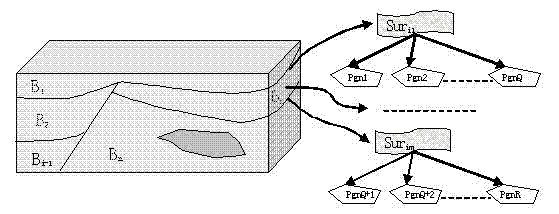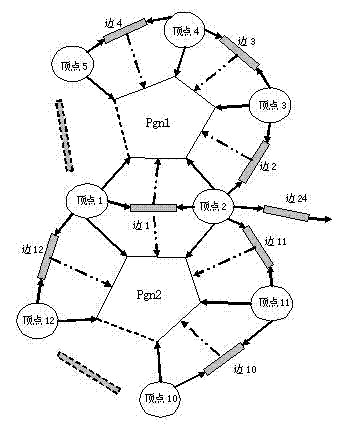Topology discovery method of space geological data based on unstructured mode
A geological data, unstructured technology, applied in the direction of image data processing, electrical digital data processing, special data processing applications, etc., can solve problems affecting the usability of models, achieve consistency and authenticity, and reduce the amount of data stored in space , the effect of enhancing the ability of spatial expression and the efficiency of spatio-temporal analysis
- Summary
- Abstract
- Description
- Claims
- Application Information
AI Technical Summary
Problems solved by technology
Method used
Image
Examples
Embodiment 1
[0071] Take the topology discovery method of the unstructured pattern of spatial geological data of a gold mine in Henan as an example:
[0072] Step 101: The effective geological data in the area mainly include drilling data, geological maps, topographic maps, geological profile maps and related information. Digitize the original data through digitizers and scanners, use Oracle database tools to manage, maintain, and process information, and use 2D GIS software to generate a series of layer files.
[0073] Step 102: Import the spatial geological data into the memory, and extract the point cloud to visualize in the window ( Figure 4 ). Perform attribute identification and classification to obtain 8 groups of vertices with the same attributes, and perform clustering and segmentation projection operations in the six directions of ±XY, ±XZ, and ±YZ, among which, Figure 5 is the clustering projection result P of the bedrock vertices in the second group of faults F1 in the +XY ...
Embodiment 2
[0087] Take the topology discovery method of the unstructured pattern of spatial geological data in the Beijing plain area as an example:
[0088] Step 201: Read in spatial geological data such as aquifer data and water level data from the heterogeneous system; perform extraction, conversion, and fusion operations on the data through the interface conversion tool to obtain grid data, wherein the number of vertices forming the polygon Pgn is 3;
[0089] Step 202: Aiming at the water level data of a certain period, obtain a series of surfaces S composed of polygons ij , and establish the corresponding multilevel surface index pointer MIP;
[0090] Step 203: Traversing the MIP algorithm through breadth search to find all surfaces Sur that constitute each aquifer ij , and establish the corresponding RTree tree to save the topological relationship between polygon-surface-entity (Table 5).
[0091] Table 5 Topological relationship between polygon-surface-solid
[0092]
[009...
PUM
 Login to View More
Login to View More Abstract
Description
Claims
Application Information
 Login to View More
Login to View More - R&D
- Intellectual Property
- Life Sciences
- Materials
- Tech Scout
- Unparalleled Data Quality
- Higher Quality Content
- 60% Fewer Hallucinations
Browse by: Latest US Patents, China's latest patents, Technical Efficacy Thesaurus, Application Domain, Technology Topic, Popular Technical Reports.
© 2025 PatSnap. All rights reserved.Legal|Privacy policy|Modern Slavery Act Transparency Statement|Sitemap|About US| Contact US: help@patsnap.com



